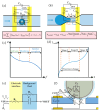Recent Advances in Microfluidic Impedance Detection: Principle, Design and Applications
- PMID: 40572403
- PMCID: PMC12195414
- DOI: 10.3390/mi16060683
Recent Advances in Microfluidic Impedance Detection: Principle, Design and Applications
Abstract
Under the dual drivers of precision medicine development and health monitoring demands, the development of real-time biosensing technologies has emerged as a key breakthrough in the field of life science analytics. Microfluidic impedance detection technology, achieved through the integration of microscale fluid manipulation and bioimpedance spectrum analysis, has enabled the real-time monitoring of biological samples ranging from single cells to organ-level systems, now standing at the forefront of biological real-time detection research. This review systematically summarizes the core principles of microfluidic impedance detection technology, modeling methods for cell equivalent circuits, system optimization strategies, and recent research advancements in biological detection applications. We first elucidate the fundamental principles of microfluidic impedance detection technologies, followed by a comprehensive analysis of cellular equivalent circuit model construction and microfluidic system design optimization strategies. Subsequently, we categorize applications based on biological sample types, elaborating on respective research progress and existing challenges. This review concludes with prospective insights into future developmental trajectories. We hope this work will provide novel research perspectives for advancing microfluidic impedance detection technology while stimulating interdisciplinary collaboration among researchers in biology, medicine, chemistry, and physics to propel technological innovation collectively.
Keywords: cell equivalent circuits; impedance; microfluidics; single cell.
Conflict of interest statement
The authors declare no conflicts of interest.
Figures







Similar articles
-
Accreditation through the eyes of nurse managers: an infinite staircase or a phenomenon that evaporates like water.J Health Organ Manag. 2025 Jun 30. doi: 10.1108/JHOM-01-2025-0029. Online ahead of print. J Health Organ Manag. 2025. PMID: 40574247
-
Signs and symptoms to determine if a patient presenting in primary care or hospital outpatient settings has COVID-19.Cochrane Database Syst Rev. 2022 May 20;5(5):CD013665. doi: 10.1002/14651858.CD013665.pub3. Cochrane Database Syst Rev. 2022. PMID: 35593186 Free PMC article.
-
Technological aids for the rehabilitation of memory and executive functioning in children and adolescents with acquired brain injury.Cochrane Database Syst Rev. 2016 Jul 1;7(7):CD011020. doi: 10.1002/14651858.CD011020.pub2. Cochrane Database Syst Rev. 2016. PMID: 27364851 Free PMC article.
-
Eliciting adverse effects data from participants in clinical trials.Cochrane Database Syst Rev. 2018 Jan 16;1(1):MR000039. doi: 10.1002/14651858.MR000039.pub2. Cochrane Database Syst Rev. 2018. PMID: 29372930 Free PMC article.
-
Computer and mobile technology interventions for self-management in chronic obstructive pulmonary disease.Cochrane Database Syst Rev. 2017 May 23;5(5):CD011425. doi: 10.1002/14651858.CD011425.pub2. Cochrane Database Syst Rev. 2017. PMID: 28535331 Free PMC article.
References
-
- Du J., Wu S., Niu L., Li J., Zhao D., Bai Y. A Gold Nanoparticles-Assisted Multiplex PCR Assay for Simultaneous Detection of Salmonella typhimurium, Listeria monocytogenes and Escherichia coli O157:H7. Anal. Methods. 2020;12:212–217. doi: 10.1039/C9AY02282A. - DOI
-
- Kumar B.K., Raghunath P., Devegowda D., Deekshit V.K., Venugopal M.N., Karunasagar I., Karunasagar I. Development of Monoclonal Antibody Based Sandwich ELISA for the Rapid Detection of Pathogenic Vibrio Parahaemolyticus in Seafood. Int. J. Food Microbiol. 2011;145:244–249. doi: 10.1016/j.ijfoodmicro.2010.12.030. - DOI - PubMed
-
- Eringen A.C. Simple Microfluids. Int. J. Eng. Sci. 1964;2:205–217. doi: 10.1016/0020-7225(64)90005-9. - DOI
-
- Terry S.C., Jerman J.H., Angell J.B. A Gas Chromatographic Air Analyzer Fabricated on a Silicon Wafer. IEEE Trans. Electron Devices. 1979;26:1880–1886. doi: 10.1109/T-ED.1979.19791. - DOI
-
- Manz A., Graber N., Widmer H.M. Miniaturized Total Chemical Analysis Systems: A Novel Concept for Chemical Sensing. Sens. Actuators B Chem. 1990;1:244–248. doi: 10.1016/0925-4005(90)80209-I. - DOI
Publication types
Grants and funding
LinkOut - more resources
Full Text Sources

